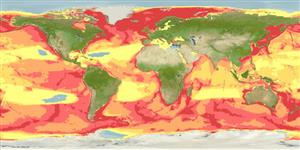Common names from other countries
Environment: milieu / climate zone / depth range / distribution range
Écologie
; saumâtre; profondeur 0 - 732 m (Ref. 116169). Tropical; 90°N - 90°S, 180°W - 180°E
Circumglobal: Balaenoptera acutorostrata acutorostrata: North Atlantic; Balaenoptera acutorostrata scammoni: North Pacific (Ref. 1522).
Length at first maturity / Taille / Poids / Âge
Maturity: Lm ? range ? - ? cm Max length : 1,070 cm TL mâle / non sexé; (Ref. 1394); 1070 cm TL (female); poids max. publié: 14.0 t (Ref. 1394)
Distributed from the tropics to the ice edges in both hemispheres. They can be seen offshore, and more often in coastal and inshore areas. They are rarely seen in some tropical pelagic areas. Minimum depth from the Pacific (Ref. 83490) and maximum depth based from their food in the Atlantic (Ref. 83488). Feeds on krill and small schooling fishes (Ref. 1394). Oceanodromous (Ref. 75906). Distributed from the tropics to the ice edges in both hemispheres. They can be seen offshore, and more often in coastal and inshore areas. They are rarely seen in some tropical pelagic areas (Ref. 1394). They are known to be 'gulpers,' feeding in separate events, often lunging at large schools of fish (Ref. 122680). Also feeds on krill (Ref. 1394). Oceanodromous (Ref. 75906).
Jefferson, T.A., S. Leatherwood and M.A. Webber. 1993. (Ref. 1394)
Statut dans la liste rouge de l'IUCN (Ref. 130435)
statut CITES (Ref. 108899)
Not Evaluated
Utilisations par l'homme
Pêcheries: commercial
FAO - pêcheries: landings, species profile | FishSource | Sea Around Us
Outils
Sources Internet
Estimates based on models
Preferred temperature
(Ref.
115969): 0.2 - 11.2, mean 2.9 (based on 10218 cells).
Résilience
Milieu, temps minimum de doublement de population : 1,4 à 4,4 années (K=0.17; tm=8).
Vulnérabilité
High vulnerability (63 of 100).
Catégorie de prix
Unknown.
